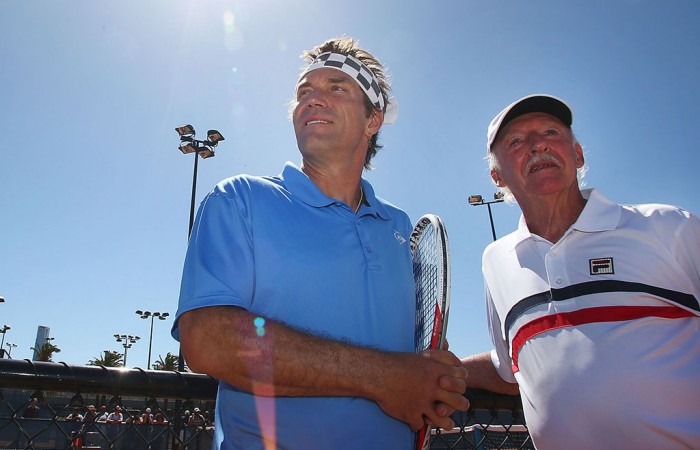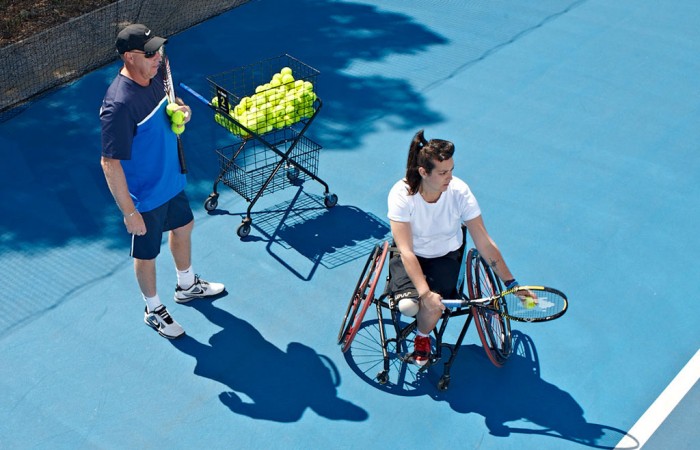Melbourne VIC, Australia, 1 May 2014 | Australian Tennis Magazine
If there is one place where the individual nature of tennis doesn’t apply it’s in practice, where rather than competing against an opponent, you’re generally collaborating with a partner to make mutual improvements. We asked some of Australia’s top coaches for advice on how to make the most from your practice sessions.
KEEP a diary
Use your diary to record key messages from your private coach, as well as the priorities that you are working on in your game. Writing in a diary will help reinforce key messages and can make you more accountable if you share them with your coach.
Before each training session or match, try writing down your process goals in your diary. Recording your process goals will assist with maintaining a narrow focus on what you want to improve during the session.
Andrew Roberts, National Academy Manager, WA
BE inspired
Create a training environment that inspires you. Two vital ingredients for a healthy training environment are quality people and a location where you feel comfortable enough to explore the depth of your abilities. It’s on the practice court where you have the freedom to develop a clear understanding of what you do well and what you can do better. Find a place of practice where you can embrace the challenge of striving to be that little bit better every time you step on to a tennis court!.
Shannon Nettle, Australian Fed Cup squad coach
HIT balls … and more balls
Hit as many balls as you can in a short space of time. When you’re drilling or warming-up, chase everything. It doesn’t matter if it’s well out or mis-hit and going into the back fence on the full – chase it and get it back into the court and keep the rally going.
The skills and imagination you require to dig out a half-volley that is a metre long or hit a drive volley even though you are well behind the baseline will stand you in good stead when you come up against better opponents in match play, as they won’t put the ball right in your strike zone.
Don’t hit winners when warming-up or drilling. Instead, put the ball into interesting places, explore the parameters of the court but all the while keep it just within reach of your training partner. If they’re struggling, float it back and give them a chance to reset the rally.
Training is a collaboration between two people and winners or errors kill the flow. The longer the ball is in play the harder you’re working mentally and physically. Train harder than match play – it’s a bit like a distance runner putting in 150kms a week to run a good marathon (42km).
Talk it up when you’re training. Speak a bit of rubbish, compliment your training partner when they do something good. Encourage them, fire up and create some atmosphere.
Wally Masur, National Academy Head Coach, NSW
KEEP the balls in play
One thing that’s extremely important when training is intensity. A good way to ensure intensity in any open drill situation is to “forget” about the lines at your end of the court and chase every ball no matter where it lands. By attempting to keep out balls in play you will also be practicing your end range defensive skills (if it lands wide), your movement back in behind deep balls (if it lands long), and your adaptability (if you decide to volley or drive volley a shot going long).
Chris Mahony, Manager National Academy, Qld
IMPROVEMENTS, not results
Approach every practice session with a purpose of improving rather than a focus on results. Too many people play practice sets or do drills where if they don’t win those sets or drills they think they haven’t had a good session and become angry or frustrated. You must practice how you’re going to play in a match regardless of the result in practice. Too many people go for shots or aim for targets in the court that aren’t realistic when the pressure isn’t on in practice and then think they can recreate they shot when the pressure is on, then wonder why they can’t do it.
Grant Doyle, National Academy Coach, Tennis Australia
THE VALUE of variety
Quality of practice is achieved through good content. Design your drills with this in mind – you are only limited by your imagination. Be aware of your strengths and weaknesses, work on both. Your strengths will set up points for you and your weaknesses opponents will be attempting to exploit.
Good technical skills will create more tactical options. If you can volley well, for example, you can mix in serve volley and finish attacking groundstrokes at net. Footwork, positioning and balance play a big part in the execution of your shots, design drills to work on this key component.
Serve and return are the first shot in every point, work on developing your routines, your variations and tactical decision-making. Consistency, accuracy and power are what you are striving for with groundstrokes, design drills to challenge self with this in mind. Above all else, remember that a positive ‘can do’ attitude with a good work ethic can take you a long way in this game, enjoy the journey.
Anthony Lane, National Academy Coach, Qld
PRACTICE with a purpose
Be it with your coach or a hitting partner, have a think about what it is you wish to work on with each session. That way you can reflect on what was successful or not and be better prepared for the next practice session. As the saying goes “failing to prepare is preparing to fail.”
Ben Pyne, National Academy Coach, NSW
INTENSE movement
So often we here about the word intensity as being a must have for quality tennis practice.
Intensity is your mind and body functioning with movement urgency related to the ball, shot selection, court geometry, opponent, time and space. The rules are simple – one bounce and keep the ball in play. Here are specific tips that will help you create that intensity in your practice:
- Be physically warmed up and ready to sprint when you start.
- Keep your motor running – feet bouncing.
- Use your eyes and memory to percept ball flight, spin, depth, pace and direction immediately upon impact – with urgency.
- Get to the ball on the first bounce or take it out of the air. If you can’t get to it on first bounce, get it on the second and if you can’t get it on the second, get it on the third.
- Chase all out balls.
- Adjust/shuffle your feet for best possible set-up, stopping to strike the ball between hips and shoulder.
- The best movement is done after the ball you have struck is travelling through the air so recover with urgency before your opponent makes contact.
- Repeat, repeat and repeat with the same urgency.
Apply this urgency and the first thing you will notice is how much your heart rate increases and you will be displaying intensity at the highest level. Learn to practice with this urgency as being the only way you know – you will become better, fitter, faster and then you will realise how much fun you have been missing out on!
Simon Youl, National Academy Head Coach, NSW
HAVE a time limit
Even a pretend one. My advice for practice is to imagine you could only practice for 45 minutes once a week! How intense, purposeful, planned and fulfilled would that session be? That should occur with every practice session – and if it isn’t, ask yourself why it’s not.
Mark Hlawaty, National Academy Coach, Vic
SET a specific goal
This is important, as the player and coach will have a plan of what they are trying to achieve or work on during the practice session and not just making it up on the spot and hitting tennis balls. The practice will then be specific and purposeful, resulting in the player improving and reaching their potential quicker.
Jarrad Bunt, National Academy Coach, NSW
BITE-SIZE pieces
There’s an old saying that if you want to eat an elephant, then don’t eat it all at once – otherwise you will get indigestion. Always eat one piece at a time. The same is true for your practice.
To maximise your time, plan the session. Break it up into parts, with simple objectives geared toward your technical, tactical, physical and mental development to reach your overall goals.
Milo Bradley, National Academy Coach, SA
BALL recognition and engagement
There are two key areas when it comes to your practice.
1. Ball recognition
From the first ball in practice I want the players using their eyes to pick up the ball – the subtleties of the bounce, the weight of the shot and the direction it is sent from. By doing this, you move with efficient purpose, prepare the racquet with time and space behind the ball and become a more influential and less reactive hitter.
2. Mental and physical engagement on every ball
Repeatability under intense pressure is what a tennis player strives for, so in practice it is important that you hit every ball with purpose and that you commit fully to that purpose. Mistakes will be made and perfection is never the goal but the player that engages mentally and physically on every shot has the ability to adapt and make adjustments, is discerning and makes better decisions.
Adam Carey, National Academy Coach, Qld
BODY of proof
As an avid golfer, I enjoy feeling strong and flexible as this has a significant bearing on maintaining good technique and creating easy power. Conversely, when your body betrays you (tightness, feeling weak) it becomes difficult to perform at your best.
So to get the most out of your practice sessions, you would be well served to ensure that you spend some time each week on your body. Some flexibility work a few times a week or perhaps a yoga session or two might find you moving more freely on the court and more able to get into good positions to execute your shots.
Mark Draper, National Academy Coach, Qld
CREATE your own reality
Even if it’s still two or three weeks away, imagine that you’re leaving for a tournament the next day. In my own practice sessions as a junior, I would often give myself “pretend” timeframes to create more urgency and focus in my training time.
Carlos Cuadrado, National Academy Coach, Vic
PRACTICE to improve but play to win
Too many people become caught up in the result in practice sessions when you’re actually just out there trying to improve in what should be considered a non-competitive environment. Take a deep breath, think about what you’re actually trying to do to work on in your game, and then chip away at trying to get it done whatever the outcome. Practice set results won’t be remembered, improvement will be. Sometimes areas of your tennis – most significantly, technical change – need to go backwards in order to go forwards. So once you’re convinced on the direction you’re taking, stick at it through thick or thin and in the long run, you will become a better player.
Once match day comes around then its time to get the competitive beast out and move into win mode. Hopefully those gains you have made in practice will help you get the desired result.
Brent Larkham, Head Coach AIS & Academy – Tennis Australia




